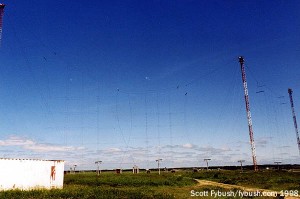NorthEast Radio Watch 12/8/2025: Cichon’s Back in Buffalo
In this week’s issue… Veteran newsman returns - Remembering NY's Leitner, RI's Jones - CT AM saved - Maine AM moves - "Indie" adds suburban signals
In this week’s issue: CBS shakes up its Boston FM lineup – Danbury’s WDAQ/WLAD move to new studios – Changes at WKRZ – Anastos off WNYW’s 10 PM news – What next for the silenced Sackville shortwave site?
by SCOTT FYBUSH
*What was that we were saying just last week about the lack of high-profile rivalries in Boston radio? As of noon on Thursday. there’s a top-40 war underway on the airwaves of eastern MASSACHUSETTS, pitting two of the nation’s biggest broadcasters against each other at the expense of one of the city’s longest-running formats.
 To listen to the final hours of WODS (103.3) as the clock ticked down to noon, y0u’d hardly have known that the station that CBS Radio launched as “Oldies 103” back in 1987 had long since transitioned from 1950s and 1960s oldies to a ’70s/’80s-intensive classic hits format.
To listen to the final hours of WODS (103.3) as the clock ticked down to noon, y0u’d hardly have known that the station that CBS Radio launched as “Oldies 103” back in 1987 had long since transitioned from 1950s and 1960s oldies to a ’70s/’80s-intensive classic hits format.
To its credit, CBS gave WODS’ staff the opportunity to say goodbye in the hours after the news broke on Wednesday afternoon that 103.3 would be flipping to top 40 as “AMP Radio.”
“I’m not closing the book, I’m just turning the page,” morning host Karen Blake told listeners during her final morning show on Thursday, thanking station management for their support, including the recent hiring of co-host John Laurenti.
In the station’s waning moments later Thursday morning, the WODS jocks who packed the studio – midday veteran Paula Street, “Elvis Only” host Jay Gordon and “Lost 45s” creator Barry Scott – took the station back to its roots, closing out with the same song that launched WODS back in 1987, the Beach Boys’ “Fun Fun Fun.” (Automation then took over for the last half-hour before the noon launch of the station’s new format, top-40 “AMP Radio,” and so technically the last song on the old WODS was actually “Last Dance” by Boston’s own Donna Summer.)
*In 1987, the biggest competition to WODS came from stations called WROR and WMJX, and that was still true (with some big twists along the way) a quarter-century later. The original WROR, the 98.5 station that had originated oldies on the Boston FM dial, had long since segued from AC to hot AC (as “Mix,” WBMX) and had become a CBS sister station to WODS, moving up the dial to 104.1. But the WROR callsign returned to the market on Greater Media’s 105.7, which made its own segue from oldies to a hit-heavy classic rock format occupying a tight demographic niche right between female-friendly WODS and another CBS sister station, male-leaning classic rocker WZLX (100.7). And the battle for older female listeners had become a tight one, too, with WODS complementing WBMX and both competing against the city’s established AC outlet, Greater Media’s WMJX (106.7), which has itself grown hotter in its music programming over the years.
 Shifting 103.3 from older-skewing WODS to the much younger-skewing “AMP” is good news for Greater Media, which stands to pick up new listeners to both WROR and WMJX, but it probably didn’t come as very welcome news up at Clear Channel’s Medford-based cluster. Since 1994, when Pyramid Broadcasting bought WJMN (94.5) to bring it under common ownership with WXKS-FM (107.9), that cluster (which has passed from Pyramid to Capstar to Chancellor to AMFM to Clear Channel over the years) has effectively controlled top-40 listening in the Boston market, using urban-leaning “Jam’n 94.5” to reach the youngest end of that demographic and allowing “Kiss 108” to skew just a little bit older.
Shifting 103.3 from older-skewing WODS to the much younger-skewing “AMP” is good news for Greater Media, which stands to pick up new listeners to both WROR and WMJX, but it probably didn’t come as very welcome news up at Clear Channel’s Medford-based cluster. Since 1994, when Pyramid Broadcasting bought WJMN (94.5) to bring it under common ownership with WXKS-FM (107.9), that cluster (which has passed from Pyramid to Capstar to Chancellor to AMFM to Clear Channel over the years) has effectively controlled top-40 listening in the Boston market, using urban-leaning “Jam’n 94.5” to reach the youngest end of that demographic and allowing “Kiss 108” to skew just a little bit older.
Being essentially the only game in town has also allowed Clear Channel to run its stations with relatively little live local content: middays on both Kiss and Jam’n are tracked from out of town, for instance, and the overnight shift on Kiss also comes from Los Angeles. After one glaring misstep in its opening montage (sorry, CBS, but nobody in Boston calls the place “Beantown”), the new “AMP” will be looking to use localism to define itself as it takes on the entrenched Clear Channel competition. In other markets where it’s launched new top-40 stations (New York’s “92.3 NOW” WXRK, for instance), CBS has tended toward more use of live, in-market talent, and it appears that will be the case in Boston, too; while AMP launches with a commercial-free jockless run through July 4, Boston market VP/programming Mike Thomas is already staffing up the new station. (Remember our mention last week that Joey Brooks was leaving CHUM-FM in Toronto to head home to Boston? It appears Brooks will be one of the first personalities on AMP.)
*No question about it, it’s sad to see such a long-running format as WODS disappear (among Boston’s commercial FMs, only WMJX and – ironically – Kiss 108 have been around longer.) But it’s also exciting to see a top-40 war in a city that hasn’t really had one in two decades – especially as we wait to see how Clear Channel responds to competition that’s hitting it at a challenging time. We still don’t know what Clear Channel has planned for its new acquisition on 101.7, the soon-to-be-former WFNX; could the end of WODS prompt a shift in plans to oldies on that signal, or could Clear Channel take 101.7 to straight-ahead hip-hop to try to solidify its dominance of that segment of the market?
 For now, that’s all purely speculative, and we likely won’t know what’s coming to 101.7 until the Phoenix hands off the FM signal July 22 and moves “WFNX” to a webcast…a webcast, as it turns out, that will have some stiff competition of its own. That was the week’s other big Boston surprise, as the Boston Globe announced that it had hired several prominent former WFNX staffers to launch its own alternative-rock webcast via its boston.com platform. The Globe says the new webcast (going, for the moment, as “Radio BDC,” as in “Boston-Dot-Com”) will feature former WFNX jocks Henry Santoro, Julie Kramer and Adam 12, former WFNX program director Paul Driscoll, and operations and promotions director Mike Snow. No launch date has been set, but we’d be surprised indeed if it’s not ready to go right at the same time WFNX says farewell to FM.
For now, that’s all purely speculative, and we likely won’t know what’s coming to 101.7 until the Phoenix hands off the FM signal July 22 and moves “WFNX” to a webcast…a webcast, as it turns out, that will have some stiff competition of its own. That was the week’s other big Boston surprise, as the Boston Globe announced that it had hired several prominent former WFNX staffers to launch its own alternative-rock webcast via its boston.com platform. The Globe says the new webcast (going, for the moment, as “Radio BDC,” as in “Boston-Dot-Com”) will feature former WFNX jocks Henry Santoro, Julie Kramer and Adam 12, former WFNX program director Paul Driscoll, and operations and promotions director Mike Snow. No launch date has been set, but we’d be surprised indeed if it’s not ready to go right at the same time WFNX says farewell to FM.
 (And two more quick notes about WODS before we move on: first, the WODS calls appear to be staying in place for now, just as “WXRK” did when New York’s 92.3 flipped from K-Rock to “NOW”. And second, as with so many big-market format shifts of late, CBS is keeping the WODS classic hits going via an HD-2 subchannel. That means the “Cove” soft AC format that had been on 103.3-HD2 is gone; it faded away unceremoniously at the end of the night last Wednesday.)
(And two more quick notes about WODS before we move on: first, the WODS calls appear to be staying in place for now, just as “WXRK” did when New York’s 92.3 flipped from K-Rock to “NOW”. And second, as with so many big-market format shifts of late, CBS is keeping the WODS classic hits going via an HD-2 subchannel. That means the “Cove” soft AC format that had been on 103.3-HD2 is gone; it faded away unceremoniously at the end of the night last Wednesday.)
*So who’s not affected by the 103.3 change? There’s just one cluster in Boston untouched by all the shuffling, and that’s the Entercom stations right across Market Street from CBS. There’s news from those stations this week, too, though: at active rock WAAF (107.3 Westborough)/WKAF (97.7 Brockton), morning host Greg Hill has quietly become a market fixture after 23 years at the helm of the “Hill-Man Morning Show.” Last week, Hill signed an extension of his contract that will keep him in place until 2017. (Even if he makes it to 28 years on WAAF’s morning drive, Hill will still lag behind at least two even longer-running Boston morning men: Carl deSuze’s nearly 40 years at WBZ, and Matt Siegel’s 31 years and still counting at Kiss 108…)
*One more Boston-market note: the scheduled ceremony for WSRO (650 Ashland)’s big power increase last week has been postponed; Massachusetts governor Deval Patrick, who was to have flipped the switch boosting WSRO to 1500 watts, was otherwise occupied on Thursday morning as the U.S. Supreme Court announced its healthcare ruling. No rescheduled date has been announced yet.

*Carl deSuze was still doing mornings at WBZ when WLAD in Danbury, CONNECTICUT moved across the street into studios on the fourth floor of the hotel at 198 Main Street in 1962 – and the station stayed put in that office suite for a remarkable 50 years…until just this past weekend. If everything went according to plan for engineer extraordinaire Tom Osenkowsky, GM Irv Goldstein and their team, WLAD (800) and sister stations WDAQ (98.3) and WAXB (850 Ridgefield and a 107.3 translator) will be reaching listeners today from their brand-new studio home at 98 Mill Plain Road on the west side of Danbury. The long-awaited move will reunite the WLAD/98Q operations staff with the stations’ business office, which ended up in a storefront four floors below the air studios on Main Street as the old hotel became the Ives Manor subsidized housing.
*A veteran MAINE morning man has quietly taken retirement. Don Brown has been a fixture on Pine Tree State airwaves ever since he signed on at WIDE (1400 Biddeford, now WVAE) back in 1957. He’s best known, though, for his many years as the morning host on WABK (104.3) in Gardiner, where he ended a 44-year run in mid-June in what he describes as an “amicable” parting with owner Blueberry Broadcasting. Brown, 72, whose real name is Don Wormwood, tells the Central Maine Morning Sentinel that he had been planning to retire this fall.
*In NEW HAMPSHIRE, Nassau is applying to move WLNH (98.3 Laconia) up in height and down in power. Instead of its present 15.5 kW/407′ C3 signal from a tower on Parade Road between Laconia and Meredith, WLNH wants to relocate to Belknap Mountain in Gilford, southeast of Laconia. From that peak, it would run 700 watts DA/1541′, still as a C3.
Up in Lancaster, a fire Tuesday evening at the studio building of Barry Lunderville’s WXXS (102.3) knocked the station off the air temporarily. As it turned out, most of the damage was to the exterior wall of the building – but it took out power to the building for more than a day as well. Nobody was injured, and there was no serious interior damage.
*We’re still gathering damage reports from the big storm that ripped its way across PENNSYLVANIA, NEW JERSEY and points west and south on Friday. While the worst of the damage was along a line that started in Indiana and then moved eastward into Virginia and Maryland, the storms knocked out power to much of the Jersey shore. Several Atlantic City-market stations were off the air over the weekend, including WMGM (103.7), but there’s no word (at least so far) of any more serious tower damage.

*The storms spared Wilkes-Barre, but over at Entercom top-40 WKRZ (98.5), there’s a storm of a different kind: morning co-host Sue Barre is departing the “Rocky & Sue Show” of her own volition to focus on her real-estate career, ending a 22-year run at the station. Sidekick Lissa takes over effective today as Rocky Rhodes’ co-host – but there’s also a vacancy in middays, where Kelly K’s job has been eliminated. (She was also WKRZ’s music director and assistant PD, and it doesn’t appear those jobs will be filled right away, either.)
Up in the Erie market, public radio WQLN (91.3) has a new translator frequency to serve Meadville. The former W207AF (89.3) was has moved to 106.1 from a higher altitude for improved coverage of the college town along I-79 an hour south of Erie.
And in Philadelphia, Zack Seward joins the news staff at WHYY (90.9) as an “innovation reporter,” a beat he helped develop as one of the inaugural members of the “Innovation Trail” reporting team in upstate New York, where he just wrapped up two years based at Rochester’s WXXI (1370). (Usual disclaimer applies: your editor is also a part-time member of the WXXI news staff, and will miss Zack greatly as he moves on to bigger things!)
*There’s a TV shakeup in NEW YORK City: after seven years as the co-anchor of WNYW (Fox 5)’s flagship 10 PM newscast, veteran anchor Ernie Anastos is being replaced on the late shift. Greg Kelly moves from “Good Day New York,” where he’s been anchoring from 7-10 AM, to take over for Anastos at 10 PM (alongside Dari Alexander) and for Harry Martin at 6 PM. Anastos will continue to co-anchor at 5 PM with Alexander, and Dave Price becomes the new 7-10 AM “Good Day New York” co-anchor.
On radio, CBS has picked a new morning man for WXRK (92.3 NOW): Ty Bentli moves from afternoons at Clear Channel’s KBIG (104.3) in Los Angeles to take the slot last occupied by Nick Cannon.
In Albany, there’s a new morning man on Pamal’s WYJB (95.5): Bill Fox returns to the station to join Laura Daniels on the “B 95.5 Breakfast Club,” replacing Chuck Taylor in that position.
South of Albany, Northeast Gospel Network’s WNGN (91.9 Argyle) translator, W272AZ, wants a change of frequency. Currently licensed to Coxsackie on 102.3, W272AZ bumps up against Clear Channel’s Albany-market WKKF (102.3 Ballston Spa), and it’s hoping a shift to 102.1 will lessen interference between those two signals.
In the southern Finger Lakes, Ithaca Community Radio has begun a full-time program schedule on its two new full-power signals. WRFI (91.9 Watkins Glen) and WINO (89.9 Odessa) came on the air with automated loops of programming while ICR completed building out a program feed from its downtown Ithaca studios to the two transmitters south and west of Ithaca. WRFI and WINO now provide the program origination to feed ICR’s Ithaca translator, W201CD (88.1 Lansing), which had been fed by the HD2 subchannel of public broadcaster WSQG (90.9 Ithaca) for the last couple of years, and by Geneva-based WEOS (89.7) before that.
*In an industry full of colorful inventors and entrepreneurs, Leonard Kahn made everyone else look black and white. Widely regarded as one of the most brilliant minds in broadcast engineering, Kahn made a name for himself in the 1970s and 1980s with the development of the Kahn-Hazeltine AM stereo system – and for the pitched legal battle that ensued between Kahn and rival system developers, earning Kahn a reputation as a tenacious defender (sometimes to his own defeat) of his ideas, patents and engineering principles.
From his Long Island laboratory, Kahn went on to develop the “Powerside” AM loudness-enhancement system, which was widely adopted in the 1980s, and the “CAM-D” digital AM broadcast system, the full details of which were never disclosed publicly. After the death in 2005 of his beloved wife Ruth, Kahn ended up living in a nursing home in Florida, where he died June 3 at age 86.

*While CANADA‘s international shortwave voice has fallen silent, the Sackville, N.B. transmitter site that served Radio Canada International for seven decades may not be gone for good – at least not just yet. Shortwave guru Kim Andrew Elliott reports that CBC transmission officials are trying to sell the 280-acre site and its forest of antennas and transmitters to other international broadcasters; if that doesn’t happen, the site might also be developed as a wind farm, and if that doesn’t come to pass, the CBC plans to raze the towers and buildings and return the site to its natural state.
(Even after Radio Canada International went dark a week ago, Sackville isn’t quite silent yet: Elliott reports several relay transmissions for Korean, Japanese, Vietnamese and Vatican broadcasts will continue until late October, and the CBC Northern Quebec shortwave service will remain on the air temporarily at 9625 kHz until several FM relays are completed in that region.)
RCI had some company in the shortwave-shutdown department last week: Friday also brought the end to English-language broadcasts at Radio Netherlands, which will be scaling back operations at the site in Bonaire, off the Venezuelan coast, that has long served North American listeners. (You can hear Radio Netherlands’ English-language farewell here.)
*Down the road in Saint John, New Brunswick, the Canadian Media Guild’s strike against Maritime Broadcasting System’s three stations is entering its second week today. The regular airstaff at CFBC (930), CJYC (98.9 Big John FM) and CIOK (K100) has been off the air since the strike began last Monday, replaced by out-of-market personalities, including some from other MBS stations. Members of the recently-formed Canadian Media Guild unit say many of the MBS employees in Saint John have been working for pay rates just above minimum wage, with not even a cost-of-living increase in a dozen years.
In Halifax, CJCH (101.3 the Bounce) has a new morning man: he’s Turk, who moves from afternoons a year after joining the CTV Radio station.
And in the Toronto suburbs, there’s a new low-power signal on the air serving the Tamil community in and around Scarborough. CJVF (105.9) calls itself “Vanakkam FM,” and it’s running just 45 watts.
From the NERW Archives
Yup, we’ve been doing this a long time now, and so we’re digging back into the vaults for a look at what NERW was covering one, five, ten and – where available – fifteen years ago this week, or thereabouts. Note that the column appeared on an erratic schedule in its earliest years as “New England Radio Watch,” and didn’t go to a regular weekly schedule until 1997. One Year Ago: July 4, 2011 – *It’s hard to believe that it was just seven years ago when Nassau Broadcasting was boasting about assembling a cluster with “more stations than any one owner has ever had in New England.” But that’s what we wrote in NERW back in March 2004, and for a while, the New Jersey-based broadcaster was flying high.
Now Nassau CEO Lou Mercatanti is taking back control of the company, but at a price: Inside Radio reports that the lenders, led by Goldman Sachs, want out of owning the company, and they’re willing to sell it back to Mercatanti at a steep discount. Thursday’s IR exclusive reports that Mercatanti’s group will pay only about a fifth of Nassau’s debt – $54 million out of $258 million that’s owed – to buy back the stations. But the Nassau that emerges will be a much smaller company, closer to the group that Mercatanti acquired from founder Herb Hobler in 1986 than the regional behemoth that it became since deregulation. The transfer of control to Goldman Sachs already forced Nassau to put several stations in a divestiture trust, and now Inside Radio is reporting that by the end of 2012, the slimmed-down Nassau will exit New England entirely, selling the rest of its stations in MAINE, NEW HAMPSHIRE and VERMONT as well as some non-core AM signals in PENNSYLVANIA. *There’s some good news for Nassau as it seeks to sell its Portland stations, at least: they’ll suddenly be in a much larger Arbitron market. The ratings service has redefined the boundaries of several markets, including Portland, to add adjacent counties to the metro. In Portland’s case, that means a sudden jump from market #168 to #89 this fall, thanks to the addition of Androscoggin, Oxford, Sagadahoc and part of York counties to what had previously been a one-county market, Cumberland. (And that, apparently, means the demise of the former Lewiston-Auburn market, too.) *The NEW YORK State Broadcasters Association said goodbye to its longtime leader in style Monday night. NYSBA’s 49th annual executive conference once again took place at the Sagamore Hotel at Bolton Landing on Lake George, and the night brought out many of the state’s most prominent broadcast leaders and an impressive dais of honorees, too. NBC Nightly News anchor Brian Williams was the last of the big names to arrive, since he had a newscast to finish in Manhattan before being flown up to the Adirondacks on what he described, with his usual dry humor, as the “smallest charter plane I’ve ever flown” to accept his Broadcaster of the Year award. It was Reilly himself who brought the house down with his musical performance as he was inducted into the NYSBA Hall of Fame, a fitting honor for the man who’s shepherded one of the nation’s largest state broadcasting groups for more than three decades. (It wasn’t Reilly’s only honor of the evening; earlier, he was presented with a proclamation from no less than Pope Benedict XVI himself.) Reilly had plenty of praise for his successor, former Associaton for Maximum Service TV head Dan Donovan, but at least for now it was hard for many in the room to imagine anyone other than the gregarious Reilly at the helm of NYSBA. *There’s nothing more definite this week about Merlin Media’s format plans for WRXP (101.9 New York) when it takes over operation of the station from Emmis later this summer, but there’s at least one more big name to add to the Merlin talent roster: veteran consultant Walt Sabo comes on board as Merlin’s chief operating officer, adding more support to the theory that Merlin honcho Randy Michaels is planning some sort of spoken-word format for the station – or that he’s playing the mother of all head games with the city’s radio community, which wouldn’t be at all out of character for him. (Meanwhile, WRXP unceremoniously cancelled the big concert it was planning for September, making it even more clear that the station’s current rock format is on the way out sometime this summer.) *The efforts of some NEW JERSEY lawmakers to stop the transfer of the state-owned NJN television network came close, but in the end Democrats in the state Senate fell one vote short in their attempt to overturn Governor Chris Christie’s plan to put the network’s four TV stations in the hands of New York-based WNET and the Caucus group run by Christie political ally Steve Adubato, Jr.
For NJN’s nine-station radio network, there was no legislative attempt to stop Christie’s outright sale of the licenses. The new owners took control of the stations at midnight on Friday, splitting the former statewide network in half. New York City’s WNYC took over the four northernmost signals (WNJP 88.5 Sussex, WNJY 89.3 Netcong, WNJT 88.1 Trenton and WNJO 90.3 Toms River), which maintain most of the former NJN Radio schedule, including the overnight simulcast of jazz from Newark’s WBGO, under the new banner of “New Jersey Public Radio.” To the south, Philadelphia’s WHYY (90.9) took over the five remaining signals – WNJM 89.9 Manahawkin, WNJN 89.7 Atlantic City, WNJZ 90.3 Cape May Court House, WNJB 89.3 Bridgeton and WNJS 88.1 Berlin – which became a straight simulcast of WHYY’s 24-hour news and information service. *A public broadcasting era came to an end in western PENNSYLVANIA on Thursday night, too: after 62 years, Duquesne University handed over operation of its WDUQ (90.5 Pittsburgh) to the new Essential Public Media consortium that includes principals of the Public Radio Capital brokerage/financing firm and Pittsburgh’s public AAA station, WYEP (91.3). The new “90.5” (which will be burying its use of the WDUQ calls until the sale to Essential closes later this year, bringing new calls with it) keeps some of the voices that were heard on the station’s previous incarnation, but there was plenty of emotion on the air Thursday as the rest of WDUQ’s staff said goodbye. Among the staffers not making the move to the new 90.5 operation were morning news anchor Alexandria Chaklos and the station’s signature jazz voice, evening host Tony Mowod.
But no sooner did the jazz fade away on “Essential Public Radio” than it was reborn in a new form. “Jazz lives. Pittsburgh sure as hell was never going to let it die,” said the blog posting on Friday announcing the August launch of a new 24-hour jazz service from PubMusic, a new programming service that will provide a variety of formats to public radio. The new service, which will include an online “Pittsburgh Jazz Channel,” will feature some very familiar names from the WDUQ era: Tony Mowod, for starters, along with former WDUQ general manager Scott Hanley and former jocks Evelynn Hawkins, John Lasanich and Dave Becker. And who’s behind the new services? None other than former WDUQ chief engineer Chuck Leavens, who was also our congenial tour guide for the transmitter visit featured on this week’s installment of Tower Site of the Week! The jazz service is just the first of several new offerings on the way from PubRadio, and we’ll be watching closely as this new operation takes root. *Belated “Happy CANADA Day” wishes to our readers north of the border, where there was a big format change to mark the occasion last week. After just a year on the air, CJOT (99.7 Ottawa) dropped its “EZ Rock” format on Thursday in favor of classic hits as “Boom” – beg pardon, “boom,” in their preferred lower-case styling.
*In Windsor, the clock is now ticking on CBC Radio One outlet CBE (1550), which made its official switch to CBEW (97.5) on the FM dial on Friday. That means the 10 kW AM signal, which enjoys wider coverage across southwest Ontario, Michigan and Ohio than the new FM outlet, will go dark no later than September 30, leaving no primary CBC Radio One outlets on AM between Manitoba and Newfoundland. Five Years Ago: July 2, 2007 – **The radio side of the newsroom at WBZ (1030 Boston) is normally a pretty quiet place after about 6 most evenings, but it was a different story last Thursday, as VIPs from all over eastern MASSACHUSETTS joined WBZ staffers past and present, along with dozens of family members, to bid farewell (for now) to evening talk host Paul Sullivan. The Lowell native had been off the air for several weeks as he recovered from a fourth brain surgery for the melanoma that he’s been fighting for more than two years, but he returned for one final show to say goodbye to his listeners. Two hours before the show started, Sullivan was already the center of attention, holding a press conference in his studio in which the serious answers about his illness and treatment were leavened by a strong dose of the humor for which Sullivan is known.
The show also featured a roster of telephone VIPs that included Mitt Romney, John Kerry and Ted Kennedy, whose barking dog prompted a flurry of Sullivan jokes. (“Is that Dick Cheney?,” Sullivan asked the senator.) Sullivan’s wife Mary Jo sat beside him throughout the broadcast, while his children joined him for parts of the show and his parents, as well as numerous aunts, uncles, nieces, nephews, in-laws and others watched and listened outside the studio window. At the end of the show, the last word on Sullivan came from producer Rick Radzik, whose usual stoic demeanor broke as he read a letter he’d written to Sullivan about how difficult it’s been to work through the illness and death of Sullivan’s predecessor David Brudnoy, followed by Sullivan’s own illness. Rich had to take over reading the last part of the letter, which gave Sullivan an opening for one more joke as he said his own farewell moments later. “This is Rick Radzik speaking,” Sullivan said after his own voice cracked as he thanked the audience. At night’s end, Sullivan continued a ‘BZ tradition begun with LaPierre’s retirement, taking a ceremonial walk down the station’s main hallway to the waiting limousine, a fitting sendoff for a host who saw WBZ through the challenges of the Brudnoy transition, only to find a style and an audience all his own. Sullivan says he’ll still have plenty to say about Bay State politics, especially as the 2008 presidential campaign cranks into high gear, and we expect to hear plenty from him in whatever role he ends up taking at ‘BZ in the months to come. A few words from this end (and no, this isn’t Rick Radzik speaking): Sullivan is, and has always been, a class act. While he’ll be the first to admit that he’s not your usual sort of radio voice, he follows in a long tradition of evening talkers on WBZ who are interesting people first and radio people second. Sullivan noted that he takes a great deal of pride in steering his own political course, and avoiding the shouting and anger that characterize so much talk radio these days. David Brudnoy was a tough act to follow, and Sullivan pulled off that difficult task. Now a new host will get to take on an even tougher act. We’re looking forward to hearing how it all comes together – and to the next chapter in the Paul Sullivan story, too. Sullivan, it turns out, wasn’t the only Boston talk host saying his farewells Thursday night. Despite a successful fundraiser, Christopher Lydon and his “Open Source” staff announced last week that they’re putting the show on hiatus. In recent months, the show had lost its network carriage via Public Radio International and its Boston home base at WGBH. Lydon and producer Mary McGrath say they’re taking the summer off to “regroup and think realistically about a new program for the fall.” They’ll keep a conversation going at radioopensource.org. With the departure of “Open Source” from the old WGBH studios at 125 Western Ave. in Allston, and last week’s move of WGBH-TV’s master control, the building that housed public TV and radio in Boston for more than 40 years is now almost empty. Only “The World” on the radio side and “Greater Boston” on the TV side have yet to make the move to the new digs at 1 Guest Street, and they’ll do that in three weeks’ time. One prominent signature of WGBH’s Western Avenue era will disappear starting today, as the pedestrian bridge that carried staffers between the two main buildings on the WGBH campus is scheduled to be demolished. There’s a new set of towers in the Hudson Valley: WGNY (1220 Newburgh) has completed construction on its new three-tower array off Route 17K just north of Stewart Airport, which will replace the “temporary” antenna that the station has been using for the last dozen years or so. WGNY will run 5 kW days, 180 watts at night from the new sticks. Not Dead Yet: Up the Hudson Valley a bit, WCKL (560 Catskill) has become a radio version of “Brigadoon,” emerging from the mists of its usual off-air status once a year around this time to broadcast for a few days and keep its license alive. This year, July 1 would have marked a year of silence for WCKL – and once again, just in time, the station was active over the weekend with a simulcast of former sister station WZCR (93.5 Hudson). *We can now put a price on WXPN’s big deal to improve its signal in central PENNSYLVANIA. The University of Pennsylvania-owned station will end up paying out $3,085,000, plus the license of WXPH (88.1 Harrisburg), in exchange for the license of Four Rivers Community Broadcasting’s WZXM (88.7 Middletown). Heading west on I-80, WDBA (107.3 DuBois) is getting new owners, as Family Life Ministries pays the Brownlee family $1.5 million for the big-signal religious outlet. Expect WDBA to become part of the Bath, N.Y.-based Family Life Network, which already reaches into parts of WDBA’s territory via several smaller transmitters and translators. And we’ll close with some sad news from CBLA (99.1 Toronto) morning host Andy Barrie: the veteran Toronto broadcaster and 12-year host of CBC Radio One’s “Metro Morning” told listeners last week that he’s in the early stages of Parkinson’s disease. Barrie says he first began to notice symptoms a year or so ago, and recently was diagnosed with the disease. He’s on vacation through August, but Barrie says he’ll be back on the air this fall, and for as long as his health permits. Ten Years Ago: July 1, 2002 – There’s a new radio station on the air in French CANADA, and it may even be legal. DX’ers have been reporting reception of Haitian-language programming on 1610 kHz, which would be “CPAM Radio Union.com”‘s new license in Montreal. But NERW hears the 1000-watt signal, emanating from a fiberglass whip antenna on Jarry Street East in Montreal, never received its official go-ahead from the CRTC to begin testing. What’s more, the programming being heard sporadically on 1610 has lacked the call letters and phone number information required for a station in test mode. Stay tuned… (Thanks to Sheldon Harvey of CIDX for supplying us with the latest on CJWI and the Canadian radio scene…) There wasn’t much of a news/talk war in MASSACHUSETTS last Tuesday; in fact, there was a big gap in the dial for a couple of hours mid-afternoon. Blame a wayward work crew on Western Avenue in Allston for the mishap, which severed a fiber and took out the Verizon switch that services WBZ (1030) and WRKO (680), leaving both stations off the air for an hour or so – and without incoming phone service for much of the day. On the FM side, “The Pharmacist”, a/k/a Brian Mulhern, has parted ways with WFNX (101.7 Lynn) and its network, where he did the morning show. With the Pharmacist, his co-host Jaxon and entertainment reporter Angie C. all having departed in the last few months, we expect word of a new morning show at the FNX network soon. A sports shuffle in PENNSYLVANIA to report: Pittsburgh’s WBGG (970) has named Fox Sports’ Stan Savran as its new afternoon talker, replacing Scott Paulsen (who’s back at WDVE); meanwhile, KDKA (1020) has named KDKA-TV sportscaster Paul Alexander as its afternoon sports anchor and evening sports host, replacing Thor Tolo. Fifteen Years Ago: July 3, 1997 – The CHR wars have taken another twist in Syracuse, which just a year ago had but a single hit radio station, the venerable WNTQ (93.1), aka “93Q”. Cox Broadcasting joined the race last year when country WHEN-FM (107.9) flipped to “Hot 107-9,” WWHT. And now there’s a third entry, noncommercial WJPZ (89.1), operated by the students of Syracuse University. “Z89” was CHR until 1995, when it joined the rush to alternative and became “The Pulse.” Now it’s back to “Z89,” but this time around with a strong dance emphasis, using the slogan “The Beat of Syracuse.” We’ll see how long a three-way fight can last, especially when one of the combatants is a hundred-watt noncomm. In MASSACHUSETTS, WBZ-TV (Channel 4) has made it official: Starting Monday, July 7, the 5-6 PM and 6-7 PM news blocks will be replaced by half-hour newscasts at 5, 5:30, and 6. Jack Williams and Liz Walker will anchor at 5 and 6, while Sean Mooney and Virginia Cha take 5:30 duties. No more sports on WBPS (890 Dedham-Boston); the last broadcast of “Sports Court” aired June 22. The station is now all leased-time, including Boston Chinese Radio, which celebrated its fifth anniversary last week with a simulcast on WBPS and WJDA (1300 Quincy). |
In this week’s issue… Veteran newsman returns - Remembering NY's Leitner, RI's Jones - CT AM saved - Maine AM moves - "Indie" adds suburban signals
In this week’s issue… Scripps stations face takeover - Sinclair moves more affiliations - CT stations sold - Maine AM surrendered - Remembering WVBR's Shapiro, WABC's Morgan
In this week’s issue… CT TV legend succumbs to cancer - Remembering PA's Adams - FCC still stalled by shutdown - Pittsburgh morning host exits
In this week’s issue… FCC faces reopening challenges - Veteran Boston anchor retires - Morning shift in Toronto - NYC FMs expand reach